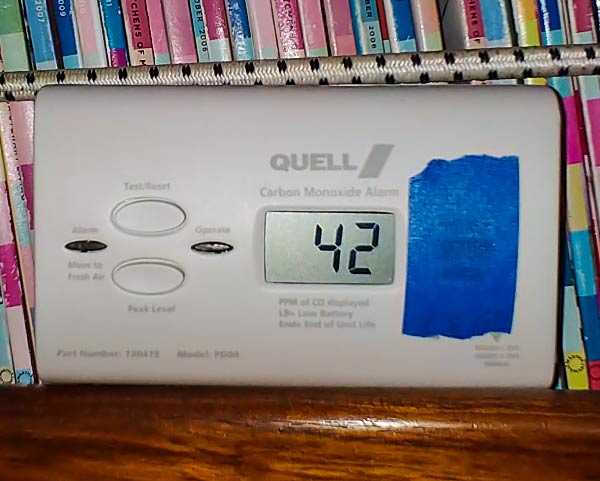November 2, 2019
We’ve had a CO detector on Legacy for the past five years or so. It’s only gone off once in still air at a marina when our neighbor was running his generator and filling our boat with the deadly gas. They only last for a limited time and ours needed replacing recently. We bought a new one at a home store and immediately started getting alarms. Why?
Possible Causes
1. There really is CO in the boat.
2. The alarm is defective.
We assumed the latter and returned the detector for replacement. The new one did the same thing. Now we’re getting worried. I did some Googling and found that some units, particular cheap Chinese ones, will detect other gasses like fuel vapor, cooking gas or hydrogen from batteries. We ran the stove with the boat closed up and the reading was zero. We ran our diesel heater, no CO. We don’t smell fuel vapor, so we’re left with hydrogen.
Hydrogen comes from non-sealed lead-acid batteries when they are charged. As far as I know, if well ventilated into a substantial area, it’ll never get to explosive levels. (The alarm on the CO detector is an unwanted consequence of a poorly made detector and not designed to detect explosive levels of hydrogen gas.) We have metal parts in our battery compartment and they are not corroding so how bad can it be?
What to do?
1. Replace our batteries with sealed batteries, like AGM or even lithium ion batteries. We had new Lifeline AGM batteries when we left on this trip and they only lasted two years. It turns out that the fine print says they need to be charged to 100% every third charging cycle. That’s just not practical for a cruising boat. Here’s more about that.
Ironically,with our increased solar capacity (about 500 watts), we could probably meet the AGM full-charge-every-third-cycle requirement now. Still, our Trojan T-105 flooded batteries seem to be in great shape and I’d rather spend the cash on wine or some other important essential.
Lithium ion batteries are just too expensive for us at this point. We’d have to consider not only the high price of the batteries ($3000 to $8000 USD) but also the cost of modifying all charging sources so that they are suitable for charging these expensive batteries with their particular charging requirements.
2. Vent the battery compartment outside the boat. That sounds easy but it would involve sealing the batteries in some kind of compartment and running a vent line to some outside point that wouldn’t take in sea water. I’m not sure there’s such a point on our little submarine!
3. Get a new detector. I guess this is the best option, but I kind of like knowing about the hydrogen. Today, for example, it was reading 42 ppm. When I looked at our battery state monitor (BM-2) I see that the solar controllers are running at the bulk charge rate of 14.8 volts. This is great for the batteries periodically, even daily, but causes the out-gassing. I put the CO monitor in the cockpit to avoid the alarm. Having to do this daily will get old when the novelty wears off.
4. Ignore it. To do that, I guess I’d just leave a battery out of the monitor until I wanted a reading, like when a neighbor is running an engine or generator. This doesn’t help us if our diesel heater malfunctions while we’re sleeping. Maybe not the best option.
Truthfully, I really don’t know what we’ll do about this. After writing this, I’m thinking AGMs or a new monitor. We’ll see.
P.S. I added the blue tape to make the alarm quieter. Without the tape, it’s a suitable volume for a Olympic stadium, not a small boat.
-Rich






